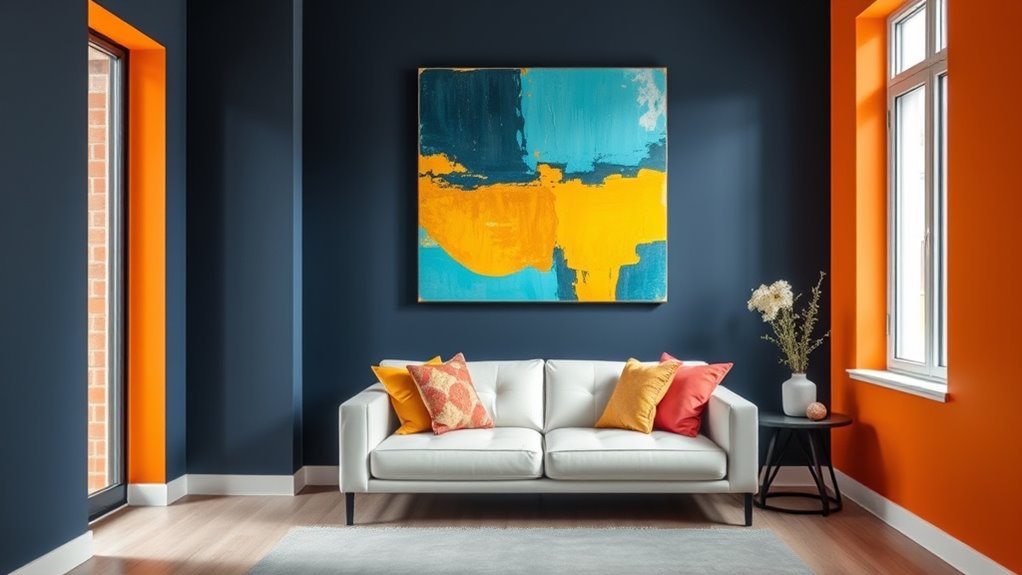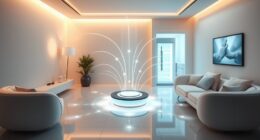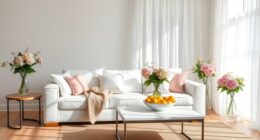To make a small room seem larger, start by using bold, contrasting colors on walls to create visual zones through color blocking. Incorporate strategic lighting and reflective surfaces like mirrors to amplify the space and enhance the illusion of openness. Position furniture thoughtfully, choosing sleek, low-profile pieces that don’t clutter the room. By combining these techniques, you’ll maximize space perception. Keep exploring to discover even more ways to transform your small room into a spacious feel-good haven.
Key Takeaways
- Use contrasting colors to define zones and create depth, making small rooms appear larger.
- Incorporate strategic lighting to enhance color vibrancy and highlight color transitions.
- Add mirrors and reflective surfaces to amplify light and extend the visual space.
- Position furniture thoughtfully with low profiles and neutral tones to maintain openness.
- Utilize minimalistic, multi-functional elements to define areas without clutter, enhancing the illusion of space.

Ever wondered how to make a bold fashion statement effortlessly? When it comes to decorating your small room, the same principle applies. Color blocking is a powerful technique that creates the illusion of space and adds visual interest without overwhelming the area. The key is to choose contrasting colors and strategically use them to define different zones or features within your room. To maximize this effect, lighting tricks play a vital role. Bright, well-placed lights can enhance the vibrancy of your color blocks, making them pop and giving your room a lively, expansive feel. Consider using directional lighting, such as spotlights or wall sconces, to highlight specific areas or color blocks. This not only draws attention to the intentional design but also adds depth, making your space appear larger. Incorporating reflective surfaces like mirrors can also amplify the light and expand the visual boundaries of your room, reinforcing the optical illusion created by color blocking. Furniture placement is equally important in amplifying the optical illusion created by color blocking. When you position your furniture thoughtfully, you reinforce the sense of openness and balance. For instance, placing a sofa against a contrasting color wall can anchor the space and create a visual flow, guiding the eye across the room. Keep larger pieces of furniture away from narrow pathways to avoid clutter, and opt for sleek, low-profile designs that don’t obstruct the view of your color blocks. Light-colored or neutral furniture works well with bold hues, allowing the colors to remain the focal point. Additionally, floating shelves or multi-functional furniture can help define zones without crowding the space, maintaining an airy atmosphere. The combination of lighting tricks and furniture placement enhances the overall impact of your color blocking strategy. Use lighting to accentuate the color transitions, perhaps by installing dimmable fixtures so you can adjust the ambiance as needed. Choose furniture that complements your color palette but doesn’t compete with it—think minimalistic and streamlined to keep the room feeling open. When you balance these elements correctly, your small room will look considerably larger and more dynamic. The visual boundaries created by contrasting colors trick the eye into perceiving more space. Remember, the goal is to create a cohesive, well-lit environment where every element works together to expand your room visually. With thoughtful lighting and furniture placement, your bold color choices will transform your small space into a stunning, roomier haven.
Frequently Asked Questions
Can Color Blocking Make a Room Feel Taller or Wider?
You might wonder if color blocking can make a room feel taller or wider. It definitely influences visual perception and plays a role in spatial psychology. By strategically placing darker colors at the bottom or top and using contrasting shades, you can create an illusion of height or width. When done thoughtfully, color blocking tricks the eye, making your space seem bigger or more proportionate without any major renovations.
What Color Combinations Are Best for Small Spaces?
For small spaces, you should choose color combinations that maximize openness and depth. Monochrome schemes work well because they create a seamless, expansive look, making the room feel larger. Incorporate bold accent walls to add visual interest without overwhelming the space. You can also experiment with subtle variations of the same color, which help maintain a cohesive feel while enhancing the room’s sense of size.
How Many Colors Should I Use for Effective Color Blocking?
Isn’t it tempting to use a rainbow of colors? When it comes to color blocking, less truly is more. Stick to two or three hues to maintain color harmony and avoid overwhelming the space. Use contrast techniques like light and dark shades to create visual interest. This approach helps your room feel larger and more cohesive, making your color blocking both stylish and effective.
Does Color Blocking Work With All Types of Furniture?
Color blocking can work with all types of furniture if you focus on good furniture pairing and color coordination. You should choose bold, contrasting colors for different sections to highlight the furniture’s features and create visual interest. Avoid overwhelming the space by balancing vibrant blocks with neutral tones. With thoughtful planning, you can make your furniture stand out and give your room a fresh, cohesive look using color blocking techniques.
Can Color Blocking Be Used in Open-Plan Layouts?
You can definitely use color blocking in open-plan layouts. It works well with color blocking furniture and wall paint techniques to create distinct zones without walls. By choosing bold or contrasting colors for different areas, you visually separate spaces, making the layout feel more organized and cozy. Just guarantee you balance the colors so the space feels cohesive. This approach adds personality and functional separation to your open-plan design.
Conclusion
By mastering color blocking, you can make small rooms appear larger and more dynamic. Remember, 60% of homeowners who use bold color blocking report feeling more energized and happier in their space. So, don’t hesitate to experiment with contrasting hues—it’s a simple trick that transforms your room’s vibe. With a little courage and creativity, you’ll turn any small space into a stunning, expansive oasis you’ll love coming home to.









